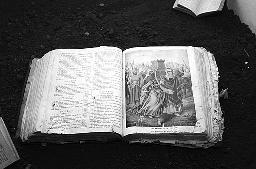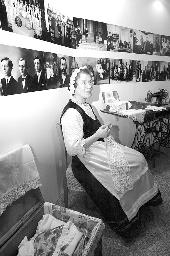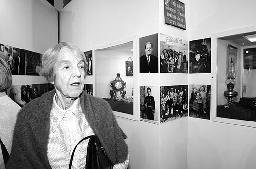









 The Krasnoyarsk Museum Complex opened its exhibition “At the turning point of
times. History and Culture of the Russian Germans”.
The Krasnoyarsk Museum Complex opened its exhibition “At the turning point of
times. History and Culture of the Russian Germans”.
About fortythousand Germans live in our region, more than sixthousand of them have their permanent residence in Krasnoyarsk. Many of them remember their German roots and try their best to cherish them. In different years and even different centuries in-migrants from far-away Germany settled in Russia by the twist of fate. The Seven Years’ War, the destroyed and weakened home country drove this diligent people to leave their ancestral places of residence to settle in unhabitated, but free Russian territories. Many first-class specialists, which Peter I. had recruited from abroad to build his huge empire, settled in and stayed forever.
- My ancestors arrived from Germany at the time when Peter I was ruling in Russia, - says Elisabeth Erhart. – They were carpenters and built the ships of the Russian fleet. We mainly dispose of oral tradition and legends of those times; however, during the past 150 years details on our family tree were continied in writing, and there even exist numerous photographs. I have many relatives, for our families always used to consist of many members – as a general rule 8-10 individuals made up a family, and they all lived in Russia. I would say that I am a Russian-speaking German, but I have ot the slightest intention to remove to Germany one day. We live here in a place, where our ancestors were buried. My grandparents died during the Leningrad blockade.
 The exhibition also shows a photo of my father, Ivan Ivanovich (according to
family tradition each first-born son was called Ivan). The pictures was taken in
1922 on the day of his confirmation in Petrograd, when, at the age of 18, he
adopted his religious belief in full awareness. Over there you see another photo
with a declaration of love to my mother and some others, as well… My parents
became victims of the blockade; they had no chance to save any objects of those
times; the only thing that yet exists is a table napkin, which my grandmother
embroidered in 1926 on the occasion of my mother’s birth. In all there were
eight such napkins – in accordance with the number of children in the family.
The exhibition also shows a photo of my father, Ivan Ivanovich (according to
family tradition each first-born son was called Ivan). The pictures was taken in
1922 on the day of his confirmation in Petrograd, when, at the age of 18, he
adopted his religious belief in full awareness. Over there you see another photo
with a declaration of love to my mother and some others, as well… My parents
became victims of the blockade; they had no chance to save any objects of those
times; the only thing that yet exists is a table napkin, which my grandmother
embroidered in 1926 on the occasion of my mother’s birth. In all there were
eight such napkins – in accordance with the number of children in the family.
The exhibition, which was organized under the planning of Vasiliy Slonov, consists of two photo series running parallel: the first is made up by black-and-white shots, the second one by colour fotos, which show today’s live in Russia. Thus, the author of the exhibition project intended to emphasize his idea of continuity and eternity.
The main idea of the exhibition, however, is to give evidence about the black pages of our history – deportation to Siberia and all the other repressions directed against the Russian Germans. Right in the middle of the composition there is a glass cross, in which you will find a number of documents with, to put it mildly, strange formulations – as they used to be made by the Russian governement, formulations which entailed death and affliction among entirely innocent people. You will read sentences about “inner enemies”, who, given only a signal from Germany, will cause explosions”, thus supporting the fascists to invade the country… The Soviet people were made to believe all this nonsense as an absolute necessity at war times. But it is completely beyond comprehension, which sins “our” Russian Germans, who had been living in Russia all times, were forced to undergo such aggressions, the more since they afflicted families with weak old people and little children.
 The people were loaded on freight cars. They just took along the most beloved
souvenirs – their Bible and objects from their family archive. Although they
were exposed in deep snow, they did not become desperate. A people, which never
stops to believe, will never be doomed – it preserves itself. The exhibition
shows a great number of bibles, printed and hand-written; they are all exposed
on sand, which was interspersed into the showcase as a symbolic meaning. The
books look all tattered by the touches of thousands of hands. German bibles
lying on Russian black earth, which was later saturated by the blood of this
courageous people. The exhibition disposes of 111 exemplars in all – and they
were all collected in Krasnoyarsk Territory by Rudolf Blumke, pastor of the
Protestant-Lutheran Church.
The people were loaded on freight cars. They just took along the most beloved
souvenirs – their Bible and objects from their family archive. Although they
were exposed in deep snow, they did not become desperate. A people, which never
stops to believe, will never be doomed – it preserves itself. The exhibition
shows a great number of bibles, printed and hand-written; they are all exposed
on sand, which was interspersed into the showcase as a symbolic meaning. The
books look all tattered by the touches of thousands of hands. German bibles
lying on Russian black earth, which was later saturated by the blood of this
courageous people. The exhibition disposes of 111 exemplars in all – and they
were all collected in Krasnoyarsk Territory by Rudolf Blumke, pastor of the
Protestant-Lutheran Church.
- My father was evacuated to Krasnoarsk, - says the project leader and chairman of the national-cultural autonomy of the Russian Germans in Krasnoyarsk Territory – Natalia Agapova, - but, as all the other Germans, he got to the trud army for a period of five years. He was a teacher, and after his release they gave him a tiny apartment at sublease. We lost any connection to our historic home country, for – until Stalin’s death – we were forced to get registered with the commandant’s office once a week and, of course, we were not allowed to leave for any other place. At the end of his life my father learned that we possibly descend from the Holland Germans (Dutch Germans), but we have no specific details on this.
 A great number of people took part in the realization of the exhibition: the
International Center of Culture, the chair of German language and the Center of
German Culture and Education of the Krasnoyarsk State Pedagogic Institute, the
Consulate General of the FRG, as well as all those, who were kind enough as to
put at our disposal the contents of the personal family archives. According to
the opinion of the organizers it is absolutely necessary to attract as many
people as possible to this exhibition, particularly young people. They all have
to see and understand the mistakes of the past, in order not to allow any
repetition of the same in the future.
A great number of people took part in the realization of the exhibition: the
International Center of Culture, the chair of German language and the Center of
German Culture and Education of the Krasnoyarsk State Pedagogic Institute, the
Consulate General of the FRG, as well as all those, who were kind enough as to
put at our disposal the contents of the personal family archives. According to
the opinion of the organizers it is absolutely necessary to attract as many
people as possible to this exhibition, particularly young people. They all have
to see and understand the mistakes of the past, in order not to allow any
repetition of the same in the future.
Stepan DENGIN.
Photos: Valeriy ZABOLOTSKIY
„Krasnoyarsk Labourer“, 26.12.2003